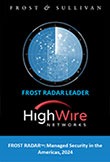XDR is the new kid on the security block. And, it’s stealing all the attention from the popular, but older EDR. Before you start feeling bad about EDR’s fall from grace, keep in mind it’s the OG and deserves our respect. That’s because XDR is building on EDR’s hard-won reputation. Without EDR, there’d be no XDR. XDR is to the entire IT stack what EDR is to endpoints alone.
Before we get too far ahead of ourselves, let’s back up and answer a few questions.
-
What exactly is XDR?
Good question. First, let’s talk about EDR, which stands for Endpoint Detection & Response. EDR tools continually monitor endpoints to detect and respond to potentially malicious events.
Similarly, XDR stands for Extended Detection & Response, where X represents any data source, such as network data, logging information, threat intelligence or community data. So, essentially, XDR enables you to rapidly detect and respond to threats across your enterprise, including your network, cloud, data center and premises as well as your endpoints.
-
So, why do we need XDR?
As you know, traditional network perimeters have expanded beyond the office premises into various data islands, such as:
- Mobile devices like smartphones, tablets and laptops
- Data centers run by enterprise organizations
- Cloud-based apps from software-as-a-service (SaaS) providers like Salesforce, Workday or Slack
- Cloud-based computing from infrastructure as a service (IaaS) providers, such as Amazon Web Services, Microsoft Azure and Google Cloud
As the network perimeter has grown, so has the attack surface for cybercriminals. And, each of these data islands, in turn, has required its own security, increasing exponentially the number of tools that IT and InfoSec staff need to manage.
-
How does it help us?
When integrated into a security platform, X Detection & Response enables us to monitor and detect every change within this “new perimeter” — no matter where it originates. This gives us visibility into the entire attack lifecycle, including intrusion, lateral movement and data exfiltration.
Because XDR solutions monitor the expanded perimeter, we can respond and counter adversaries’ movements faster and across a broader range of attack vectors, not only the endpoint.
-
Isn’t that what SIEM does?
Sort of, but not quite. SIEM, or Security Information & Event Management, pulls log data from various IT systems, collects them in one place and, hopefully, produces more meaningful security alerts. However, it’s only a detection tool, there’s no response.
-
What are the benefits of XDR?
X Detection & Response breaks down the silos that have emerged over time among traditional cybersecurity technologies. As a result, it can reduce the time and complexity of threat detection, event triage, incident investigation and response. This, in turn, helps us to become more proactive, boost the efficiency and effectiveness of our security operations, and ultimately improve our security posture.
-
How can we source XDR?
X Detection & Response is implemented as a platform, rather than as an individual product you buy and install on your network. For instance, High Wire Networks has integrated XDR into its Overwatch Managed Security Platform as a Service. Incidentally, this “as a service” delivery model makes XDR easier to deploy, maintain and manage, offloading work from overworked IT and InfoSec staff.
Ready to simplify cybersecurity with XDR?
Contact High Wire Networks to learn more about Overwatch today!
Email: overwatchsales@highwirenetworks.com
Phone: 630-635-8477









Leave a Reply